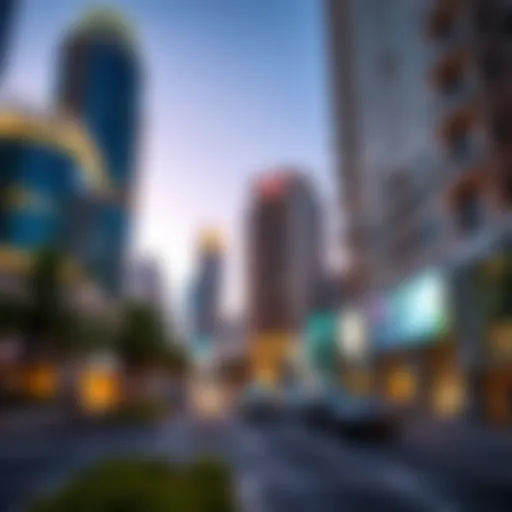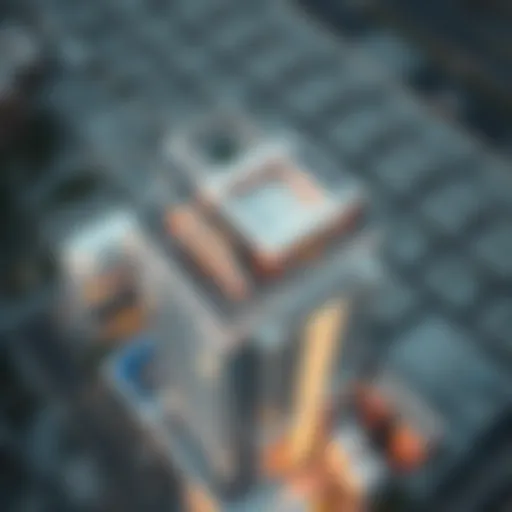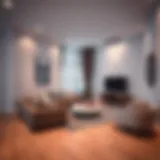Exploring the Dream Tower's Influence on Dubai's Skyline


Intro
As the sun sets over the Gulf, casting long shadows across the sandy expanse of Dubai, the skyline transforms into a tableau of modernity and ambition. Ah, but amidst this architectural proportion, one structure stands apart, towering our imaginations – the Dream Tower. It’s not just another high-rise. Rather, it embodies Dubai’s relentless quest for grandeur through cutting-edge design and innovative construction techniques.
In this exploration, the narrative will unfold the design philosophies that guided the construction of Dream Tower, complemented by an analysis of its implications on urban development. By meticulously dissecting the relationship between this monumental structure and the ever-evolving real estate market of Dubai, we gain insights into the broader socioeconomic dynamics at play.
Through the lens of the Dream Tower, we will delve into market trends that shape investor decisions, lifestyle enhancements for residents, and the emerging opportunities for buyers. The ambition here is not merely to appreciate a piece of art but to understand its profound impact and relevance amidst the cacophony of drone-out skyscrapers and the ever-churning tides of the real estate sea.
"The Dream Tower isn't just about height; it’s about the dreams that drive people to invest, live, and thrive in a city that never seems to rest."
This guide will take the reader on a journey from the contemporary design stories behind the façade to the realities of living in the luxury this tower promises. Consider it a canvas, painted with the aspirations of a city that gets bolder with each passing decade. By the end, one can expect to perceive the Dream Tower not just as a structure, but as a symbol of Dubai's ambitious future.
Intro to the Dream Tower Concept
The Dream Tower concept represents a bold step in Dubai's architectural journey, one that encapsulates the ambitions and dreams of a city that has become a global icon. This landmark embodies what modern architecture can achieve, symbolizing Dubai's aim to blend luxury, sustainability, and innovative design seamlessly.
In discussing the Dream Tower, we must focus on several key elements that highlight its significance. First, it is essential to understand that the Dream Tower acts not just as a building but as a catalyst for further development in the region. The structure is designed to attract attention, drawing in visitors and investors alike. The very essence of this tower is intertwined with Dubai's relentless drive for progress and recognition on the world stage.
The benefits of the Dream Tower are multifaceted. For one, it has the potential to enhance the skyline, standing tall among other architectural feats like the Burj Khalifa and the Burj Al Arab. This presence reshapes not only the visual impact but also the perception of what is possible in urban environments. Moreover, the tower aims to serve as a hub for business and tourism, contributing to the city's economy in ways that ripple outwards into neighboring districts.
Considerations about the Dream Tower extend beyond aesthetics and utility. It offers lessons in sustainable construction practices, which have become critical in contemporary architecture. The integration of green technologies reflects a growing consciousness among developers and the public regarding environmental impact, promoting a sense of responsibility towards future generations. Such designs also align with Dubai’s broader goals for sustainability and innovation.
Ultimately, the introduction of the Dream Tower within this article provides a foundation for exploring its historical context, architectural distinctive features, cultural implications, and far-reaching effects on Dubai's urban landscape. As we delve deeper into its impact, the Dream Tower stands as a testament to the relentless spirit that defines Dubai, promising not only to reshape its skyline but to influence the very essence of urban living in this thriving metropolis.
"The Dream Tower symbolizes not just a structure, but a vision—a bold step into the future of architectural excellence in Dubai."
By taking the time to understand these layers of the Dream Tower, investors, agents, buyers, and analysts can appreciate the broader implications of this project, grasping how it intertwines with economic, cultural, and developmental narratives that define Dubai today.
Historical Context of Dubai's Architectural Landscape
Understanding the historical backdrop of Dubai's architectural journey is like connecting the dots in a vast and intricate mosaic. The evolution of this city, from a humble fishing village to a modern marvel, sets the stage for the emergence of iconic structures such as the Dream Tower. This context not only enriches our appreciation for the tower itself but also highlights the socio-economic transformations that have shaped Dubai's skyline. The exploration of this trajectory offers valuable insights into how architecture reflects broader themes of ambition, identity, and innovation.
Early Developments and Influences
In the beginning, Dubai's architecture was a product of necessity, interwoven with its geographic and cultural influences. The early structures were modest, constructed from traditional materials like coral and mud. Buildings were primarily functional, housing families and providing shelter from the harsh desert climate. The use of wind towers, known as barjeel, served as natural air conditioning systems, showcasing the ingenuity of local craftsmanship.
Artisan skills passed down through generations played a crucial role in shaping Dubai's identity. Structures such as the Al Fahidi Historical Neighbourhood emerged, drawing on Islamic architectural principles. This area was pivotal as it preserved traditional architecture, serving as a stark contrast to the city's modern developments today.
The diamond-in-the-rough days of the mid-20th century marked a shift in Dubai's architectural landscape. With the discovery of oil in 1966, the influx of wealth catalyzed ambitious projects. It was unsought blessings and burdens mixed together, pushing Dubai into a new era, ripe for architectural transformation.
Transition to Modern Architecture
The transition from traditional to modern architecture in Dubai was not just about adopting new styles; it was a cultural metamorphosis. The 1970s and 1980s heralded luxurious developments, the likes of which would alter both the skyline and societal aspirations. Glass skyscrapers began to sprout, each vying for attention and prestige. The influence of international architects introduced new design paradigms, turning the city into a playground for innovation.
A notable example is the Burj Al Arab, symbolizing opulence and a new architectural language. This period witnessed architects like Tom Wright redefine what was possible. The Dream Tower, in its conception, channels much of this ethos—mixing contemporary styles with enduring values of sustainability and community.
The convergence of globalisation, tourism, and investment fostered a unique architectural identity for Dubai. Buildings no longer served merely as structures; they became emblems of an aspirational lifestyle. The growing appetite for innovative designs encouraged new interpretations, leading to an architectural renaissance that continues to evolve.
In summary, the historical context of Dubai's architectural landscape is a compelling tale of transformation and aspiration. The journey, marked by humble beginnings and explosive growth, not only lays the groundwork for developments like the Dream Tower but also illuminates the ever-evolving identity of Dubai itself. By understanding these layers of history, investors and stakeholders can better appreciate the value and significance of contemporary projects within this vibrant market.
Defining Characteristics of the Dream Tower
The Dream Tower stands as a beacon of architectural creativity and innovation, making it a pivotal reference point in discussions about modern buildings in Dubai. Its significance stretches beyond mere aesthetics; it intertwines with the cultural, economic, and social life of the city. This towering structure not only contributes to the skyline but also embodies the spirit of Dubai—ambitious, forward-thinking, and dynamic.
Architectural Style and Design Elements
The architectural style of the Dream Tower is a blend of contemporary sophistication and cultural symbolism. It is designed to reflect the three core values that define Dubai: innovation, tradition, and community. The building's exterior features sleek glass and steel, creating a mirror-like effect that reflects the vibrant colors of the city. This characteristic is quite intentional, as it allows the tower to harmonize with its surroundings while also making a statement of its own.
One defining design element is the unique curvature of the structure. This design choice was not merely for visual appeal; it serves a functional purpose by reducing wind resistance, making it more resilient against harsh weather conditions. Moreover, the building incorporates traditional Arabic motifs in its facade, ensuring that it connects with the cultural heritage of the region. The combination of these elements demonstrates both creativity and practicality, important considerations in architecture.
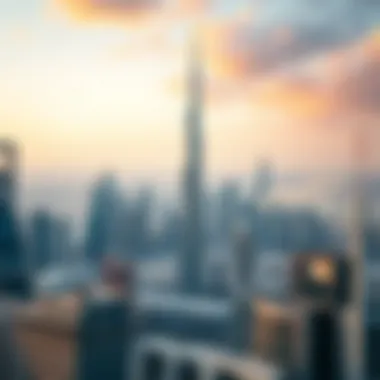
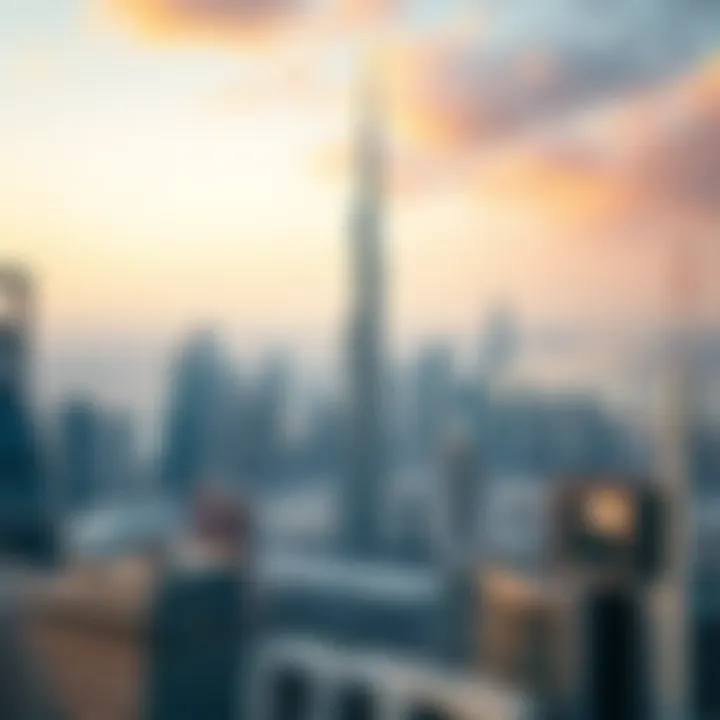
Materials and Construction Techniques
When discussing the Dream Tower's defining characteristics, the materials used in its construction are paramount. The building utilizes high-performance concrete and eco-friendly materials whenever possible, reflecting a commitment to sustainability. This choice not only enhances structural integrity but also plays a role in reducing the building's overall carbon footprint.
Advanced construction techniques have been employed, such as prefabrication and modular design. These methods streamline the construction process and minimize waste. A notable aspect is the use of smart building technology integrated within its framework. Such technology optimizes energy efficiency through automated systems that regulate lighting, temperature, and security, ensuring a contemporary living and working experience.
Sustainability Features
The Dream Tower does not just focus on structural and aesthetic appeal; it also prides itself on sustainability features that set a benchmark for future developments. It is designed to maximize natural light, thereby reducing energy consumption during the day. Solar panels are strategically installed, augmenting the building’s energy supply and underlining a commitment to renewable energy sources.
Additionally, the tower incorporates green spaces, including rooftop gardens and vertical green walls. These features not only soften the appearance of the structure but also improve air quality and encourage biodiversity. This integration of nature into urban spaces is increasingly recognized as essential for enhancing the well-being of residents and visitors alike.
"Sustainability isn’t just a buzzword; it’s embedded in the very fabric of the Dream Tower."
By placing emphasis on sensible design and sustainable practices, the Dream Tower encapsulates a vision of what urban living can aspire to be in the 21st century, making it a noteworthy subject of study for investors and analysts alike.
Overall, the defining characteristics of the Dream Tower—its architectural style, materials, construction techniques, and sustainability features—underscore its role as a significant architectural point of reference in the ever-evolving landscape of Dubai.
Cultural Significance of the Dream Tower
The Dream Tower is more than just a stunning piece of architecture in Dubai; it serves as a contemporary symbol of the city’s identity and aspirations. The cultural significance of this tower cannot be understated. It encapsulates the triumphs, challenges, and ambitions of a city that has transformed from a small fishing village into a global powerhouse in the span of just a few decades. Understanding this cultural framing helps to appreciate the role that the Dream Tower plays not only in the skyline but also in the collective psyche of its residents.
Symbolism in Modern Dubai
The Dream Tower stands tall as a beacon of hope and innovation. To many, it represents the endless dreams and aspirations of Dubai’s diverse populace. Here, cultures intersect, and the blend of human ambition and architectural ingenuity is palpable. With its modern lines and futuristic facade, the tower challenges conventional notions of what urban architecture can achieve.
As many locals might say, "It’s not just a building; it’s a manifestation of our hopes for the future." Across the world, the Dream Tower has gained a reputation for pushing the envelope in terms of design and functionality, thus symbolizing Dubai’s daring approach to development. In a city known for its lavish lifestyle and aspirational ethos, the tower's presence serves as daily motivation for its citizens to strive for excellence and to achieve their dreams.
Influence on Local Art and Design
The Dream Tower has also managed to leave its mark on the local art scene and design philosophy. Artists and designers in Dubai increasingly draw inspiration from the tower’s sculptural form and bold aesthetic. This is evident in various art installations and design projects that reflect the principles of fluidity and modernism that the tower embodies.
For instance, contemporary works showcased in public spaces often play on geometric shapes, mirroring the tower’s architectural elements. Designers in the city now find themselves using innovative materials and techniques that echo the ideals represented by the Dream Tower. Local galleries are also beginning to feature exhibitions that explore themes of urbanity and transformation, mirroring the story that the Dream Tower tells.
Moreover, as a visual landmark, the tower has become the backdrop for numerous cultural events and festivals, attracting artists and showcasing cultural diversity. Indeed, it not only represents architectural prowess but also serves as a canvas that bridges the gap between art and everyday life.
To summarize, the Dream Tower is not just a structure; it’s an emblem of modernity and a wellspring of creativity that resonates with the spirit of Dubai. As it continues to shape the urban landscape, it equally influences the cultural narratives that define the city, showcasing an unyielding embrace of innovation and art.
Urban Development and Its Impacts
Understanding the role of urban development concerning the Dream Tower is crucial within the broader commentary on Dubai's architectural identity. The Dream Tower is not merely an individual building; it embodies the evolving landscape of urban planning, inviting both critique and admiration. When we look beyond the glitzy exterior, we see a structure deeply woven into the urban fabric, influencing its surroundings in numerous ways.
Integration into the Urban Fabric
The Dream Tower stands as a testament to the principles of integration in urban design. Situated in a bustling corridor of Dubai, this architectural marvel plays a pivotal role in coordinating the flow between residential, commercial, and recreational spaces. It's designed to enhance accessibility, facilitating movement for pedestrians and commuters alike. The interplay between its towering presence and the surrounding streetscapes creates a synergy that enhances everyday life.
- Connectivity: With dedicated pathways and transportation links, the Dream Tower effectively bridges gaps in the urban landscape, fostering a sense of community.
- Mixed-Use Spaces: The tower's incorporation of residential, retail, and recreational facilities allows it to cater to various demographics, from families to business professionals. This melding of purposes elevates the livability of the area.
- Public Spaces: Gardens, lookouts, and open-air markets integrated into the development provide vital green spaces, encouraging social interaction within a rapidly urbanizing environment.
The design further signifies a move toward smart city planning methodologies that utilize technology to improve urban living. Sensors and connectivity solutions play essential roles in ensuring the Dream Tower operates efficiently within Dubai’s digital landscape.
Impact on Surrounding Neighborhoods
As the Dream Tower rises, its shadow casts an array of implications across nearby neighborhoods. The effects can be both beneficial and challenging, shaping local economies and communities in unforeseen ways.
- Economic Growth: The influx of investment and tourism brought about by the Dream Tower has the potential to revitalize struggling areas nearby. New businesses emerge, local shops thrive, and job opportunities multiply, creating a ripple effect benefiting locals.
- Gentrification Concerns: With rising property values, there’s a risk that long-time residents may feel the pinch. As demand grows, affordability becomes a pressing issue. This phenomenon, often referred to as gentrification, raises questions about community displacement and cultural erosion.
- Cultural Exchange: The cosmopolitan nature of the visitors and residents brought by the tower contributes to cultural diversity. This exchange breathes new life into local traditions while also allowing old customs to be showcased to a broader audience.
"The Dream Tower is not just a building; it's a backdrop for stories woven by the people who inhabit its spaces and the cultures it attracts."
Navigating these dynamics explains the direct correlation between the Dream Tower and its surrounding vicinity. As we analyze the Dream Tower’s influence on urban development, it becomes clear that it carries much more than mere bricks and mortar; it holds the promise of a future where architectural innovation and community well-being coalesce thoughtfully.
Economic Implications
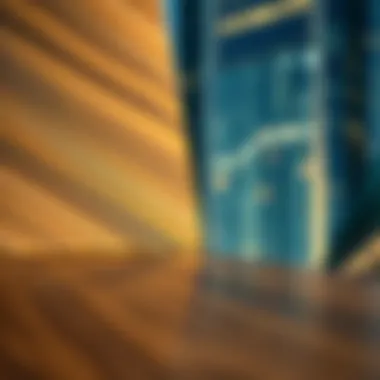
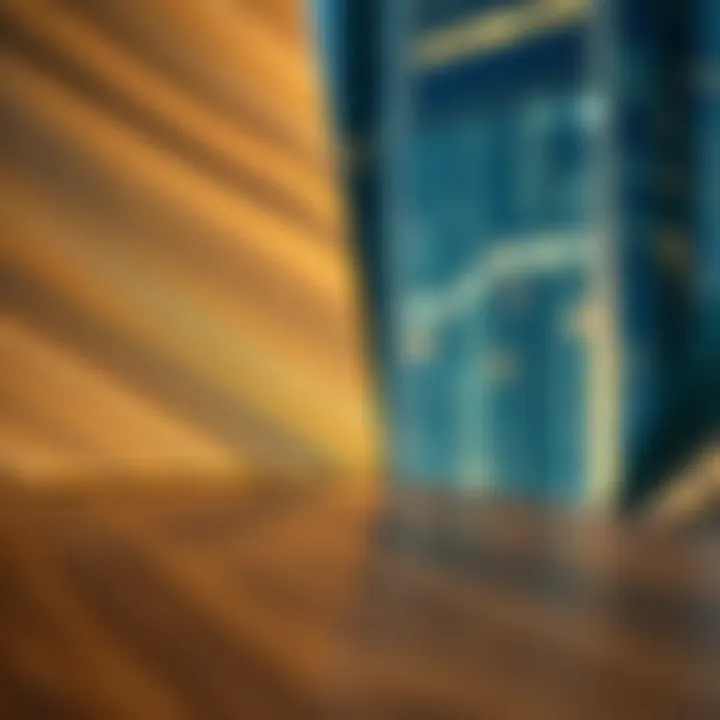
The Dream Tower serves as a beacon of prosperity in Dubai, reflecting not just architectural brilliance but also the economic ambitions of the city. Its construction has woven itself into the economic fabric of the region, influencing various sectors from real estate to tourism. Understanding the economic implications tied to the Dream Tower is crucial for investors and stakeholders who wish to grasp the underlying dynamics that drive growth in Dubai’s ever-evolving market.
Investment Opportunities Linked to the Dream Tower
The Dream Tower has created a veritable gold mine of investment opportunities in Dubai. With its iconic stature and strategic location, it attracts a diverse range of investors looking to tap into the booming property market. Here’s how:
- Commercial Real Estate Development: The tower not only houses luxury apartments but also premium office spaces. This dual function opens the door for businesses seeking prestigious addresses, making investments in surrounding commercial properties ripe for the picking.
- Retail Revenue Streams: Anticipated commercial areas within the tower promise significant foot traffic. High-end retail operations looking to leverage this influx of visitors will find ample opportunities to establish a foothold in the luxury segment.
- Hospitality Sector Growth: The Dream Tower's status as a major landmark positions it well to benefit local hotels. Investors can explore opportunities in hospitality, from boutique hotels to larger resorts catering to global tourists drawn to the tower's allure.
"In Dubai, real estate is not just about buildings; it's about creating experiences that resonate on a global scale."
Moreover, financial institutions are evaluating the economic ripple effects of the Dream Tower, as they consider funding ventures connected to its ecosystem. As such, investor confidence is poised to surge, further amplifying economic growth.
Potential Shift in Real Estate Values
The presence of iconic structures like the Dream Tower can lead to significant fluctuations in real estate values within both immediate and adjacent neighborhoods. When noteworthy developments arise, nearby properties often experience a shift in desirability, thereby affecting market dynamics.
- Increased Property Values: The Dream Tower is likely to elevate property values in its vicinity. An array of luxury units and upscale living spaces nearby becomes increasingly attractive to affluent buyers seeking convenience and status.
- Gentrification: With an influx of investments and advancements, one can expect shifts in neighborhood demographics. Areas surrounding the tower may undergo gentrification, wherein long-standing properties are renovated or repurposed, leading to a change in character and an uptick in market prices.
- Longer-term Economic Resilience: Investors keeping a keen eye on the market will notice that established economic indicators correlate with the presence of such landmarks. Properties in close proximity to the Dream Tower may prove to be more resilient during economic downturns, owing to heightened demand and sustained investments.
Impact on Tourism and Local Economy
The Dream Tower is not just an architectural showcase; it plays a pivotal role in shaping Dubai’s economic landscape, particularly in tourism. Understanding its impact on tourism and the local economy reveals how a single structure can catalyze growth, attract international visitors, and foster sustainable economic development in a bustling metropolis.
Attracting Global Visitors
The allure of the Dream Tower lies in its striking design and unique offering. Since its inception, the tower has captured the attention of millions from around the globe. People don’t just come to see a building; they are drawn by the experience it promises.
- Iconic Status: The Dream Tower represents a blend of innovative architecture and cultural significance, thus positioning itself as a must-see attraction. Visitors flock to Dubai to take in sights across its skyline, with the Dream Tower often being at the forefront of these excursions.
- Events and Activities: The tower is home to multiple venues that host events, exhibitions, and performances. These occasions serve to draw attention and visitors from all walks of life. When global tourists learn about a concert or cultural event being held at such a landmark, it nudges them to plan a trip to Dubai.
- Social Media Buzz: With social media playing a crucial role in travel decisions, the Dream Tower has become an Instagram-worthy subject, getting shares and likes that amplify its visibility. It's not just about the building itself; it's the stories and memories created there that pique interest.
All these factors combined highlight how the Dream Tower actively works to pull visitors into Dubai, offering experiences that go beyond the ordinary.
Enhancing the Visitor Experience
The experience visitors get at the Dream Tower extends well beyond gawking at its grandeur. Attention to detail in its design amplifies what may be boned as a simple visit into a memorable journey.
- Accessibility and Convenience: The tower is designed to make navigation easy, with clear signage and amenities that cater to diverse visitors. This careful consideration fosters more extended stays, ensuring tourists linger longer within the surrounding area.
- Local Partnerships: Collaborations with local businesses enhance the overall visitor experience. Nearby restaurants, shops, and entertainment venues are often promoted through the tower, allowing tourists to engage more deeply with Dubai’s culture and offerings.
- Guided Tours and Information: A variety of guided tours provide visitors with historical insights and anecdotes about both the Dream Tower and its surroundings. This can be elements like architectural tours or walking experiences, ensuring that guests leave with a sense of place.
- Merchandising and Hospitality: Offering exclusive merchandise and top-notch hospitality services boosts local retail economies. Shops inside the tower can feature local artisans, while restaurants may focus on serving traditional Emirati dishes, thus deepening the engagement visitors feel with the locale.
"A city is not just buildings; it's the experiences layered within them. The Dream Tower embodies that philosophy by enhancing the journey for all who visit."
Challenges in Realizing the Dream Tower Vision
As we delve deeper into the ambitious vision of the Dream Tower, it becomes clear that every glittering facade and state-of-the-art technology comes with its own set of challenges. Understanding these impediments is pivotal, showcasing not just the trials faced, but also the resilience and creativity required to overcome them. The complexities of urban architecture in a city like Dubai, where dreams are often as tall as the skyscrapers, are manifold.
Regulatory and Compliance Issues
Navigating through the regulatory landscape in Dubai is anything but a walk in the park. The authorities set stringent parameters to ensure that any new development adheres to safety, sustainability, and environmental criteria. One must also consider the approval processes that can slow down even the most meticulously planned projects. For the Dream Tower, compliance with Dubai's evolving building codes and zoning regulations poses a considerable hurdle.
- Safety Standards: Structures need to meet high standards for safety and resilience against the region's specific climatic challenges, including sandstorms and high temperatures.
- Environmental Regulations: In light of the growing importance of sustainable building practices, projects like the Dream Tower must incorporate eco-friendly solutions, which can sometimes lead to increased costs and engineering complexities.
- Cultural Factors: The design and function of such landmarks must respect the cultural sentiments of the local populace, adding another layer of scrutiny before approvals are granted.
Given these considerations, every stakeholder from architects to investors must be well-versed in the legal frameworks that shape the Dream Tower’s vision.
Public Perception and Reception
Public sentiment can significantly influence a project’s success or failure. Therefore, understanding the community’s views around the Dream Tower is key. While many view it as a beacon of modernity, there are contrasting opinions among the residents of Dubai.
Some people express excitement about the potential for economic and cultural rejuvenation that the Dream Tower brings, fostering local pride and attracting global attention. However, dissenting voices raise points about the rapid pace of development in Dubai.
- Fear of Gentrification: Long-time residents worry that luxury developments like the Dream Tower may displace local communities and escalate living costs subsequently.
- Cultural Sensitivity: Many hope that while Dubai becomes a hub for modern architecture, it does not lose its traditional essence, and thus question the harmony of such projects with existing neighborhoods.
- Visual Impact: The sheer size and design of the Dream Tower could be perceived as overshadowing smaller, historical buildings, leading some to advocate for a balance between innovation and preservation.
Ultimately, the success of the Dream Tower will be indicated not just by its architectural achievement but by the level of acceptance it garners from those who call Dubai home. The yin and yang of excitement and skepticism reflect the intricate dance of change and continuity that defines Dubai's ever-evolving urban landscape.
Future Prospects of the Dream Tower
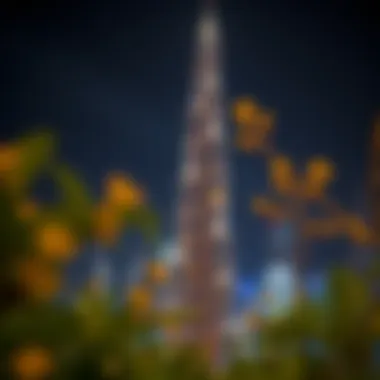
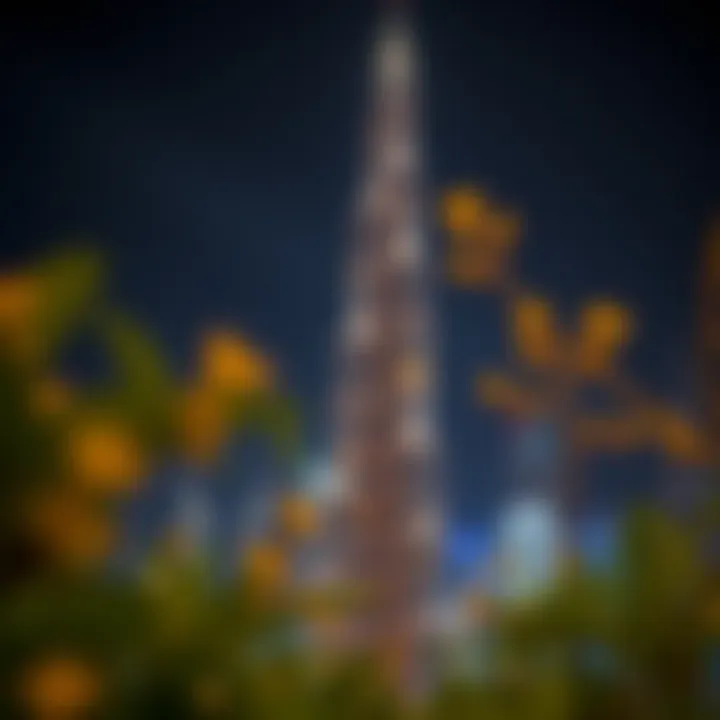
The future of the Dream Tower holds significant implications not just for its immediate surroundings, but for Dubai's skyline as a whole. As the city continues to grow and evolve, understanding these prospects will offer investors, architects, and urban planners key insights into how urban space can be enhanced to meet the demands of a dynamic population. The Dream Tower may serve as a benchmark for future projects, representing a model of harmonious living, thriving economy, and cultural integration.
Predicted Trends in Urban Development
To look ahead, one must consider the trends forming in urban development spaces across the globe. In cities like Dubai, a melting pot of cultures and ideas, some notable trends can be predicted:
- Mixed-Use Developments: The future will likely see a surge in mixed-use projects that combine residential, commercial, and recreational spaces. The Dream Tower, with its potential to feature various amenities, stands to embody this trend, catering to busy professionals and families alike.
- Smart Technology Integration: As technology continues to advance, integrating smart features into buildings is becoming a standard practice. This means in the future, features such as smart climate control or state-of-the-art security systems in the Dream Tower will not be merely an option but an expectation.
- Sustainability Practices: Urban development must embrace the principles of sustainability. Enhanced green spaces, energy-efficient designs, and intentional waste management will become paramount. The Dream Tower’s vision will likely align with these practices, thus further enhancing its reputation within Dubai.
- Community-Centric Design: Urban centers are shifting towards creating spaces that promote community engagement. This embodies parks, gathering spots, or community centers being part of the architectural blueprint, pushing the Dream Tower to not just serve residents but engage the wider city.
"A city is more than its skyline; it’s about the community that thrives within it. The Dream Tower aims to expand what urban living means in Dubai."
Long-term Investment Potential
When evaluating the long-term investment potential of the Dream Tower, several factors offer promising insights:
- Location Advantage: Positioned in one of the prime areas of Dubai, the Dream Tower is set to benefit from the city’s ongoing expansion. Upcoming transport links and amenities ensure vested interests will flourish.
- Rising Demand for Luxury Living: As global wealth continues to rise, demand for high-end residences shows no signs of slowing down. The Dream Tower’s luxurious offerings are likely to attract both international buyers and locals looking for opulent lifestyle changes.
- Growing Tourism and Business: With expansions in tourism and an influx of international businesses, properties catering to this demographic often see appreciating values. The Dream Tower aims to offer not just residences but also spaces for events, making it a hot spot for tourists and businessmen.
- Favorable Economic Climate: Dubai's intention to diversify its economy beyond oil into tourism, technology, and finance supports the attractiveness of investments in real estate. The structuring of the Dream Tower is aligned with this vision, likely ensuring long-term stability and growth for investors.
In summation, the future prospects of the Dream Tower resonate with broader trends in urban development while ensuring keen investment potential. This feat not only tells a tale of architectural brilliance but also illustrates a commitment to creating a vibrant, sustainable, and economically viable space within Dubai's ever-evolving skyline.
Further Reading
For interested investors and analysts:
- Dubai Real Estate Market Overview - ENBD
- Trends in Urban Development - The Urban Land Institute
- Sustainable Architecture Practices - The World Green Building Council
These resources provide deep dives into the current state and future of urban development in Dubai and beyond.
Culmination
The conclusion of this exploration holds significant weight in shaping the overall understanding of the Dream Tower's role in Dubai's urban tapestry. Throughout this article, we've uncovered a myriad of aspects—ranging from its architectural grandeur to its economic implications—each contributing uniquely to Dubai's skyline. The Dream Tower is not merely a building; it symbolizes an evolution in urban living, engendering a narrative that intertwines progress, culture, and innovation.
One essential consideration is how the Dream Tower embodies the ambitious vision of Dubai as a global city. It serves as a physical manifestation of the city’s aspirations and its ongoing journey toward modernity. The dream was to create a landmark that would attract talent, tourists, and investors alike. This structure has undoubtedly succeeded, claiming its rightful place alongside other remarkable edifices like the Burj Khalifa and the Burj Al Arab.
Moreover, the building's integration into the city's fabric cannot be overlooked. Its presence influences local real estate values, offering new business and residential opportunities. The economic aspect is crucial; investment prospects surrounding the Dream Tower contribute to the city’s financial health, enhancing the local economy.
In terms of lifestyle, the Dream Tower adds to the diverse offerings available in Dubai. Residents and visitors can relish in the conveniences and luxuries provided, leading to an elevated quality of life that attracts a global audience.
Ultimately, this concluding section emphasizes that the Dream Tower is not merely an architectural feat but a catalyst for discussion, community growth, and international attention. Its impact is expected to resonate for years to come, providing valuable insights for investors, agents, buyers, and analysts focused on the pulse of Dubai's dynamic real estate market.
"In a city bursting at the seams with ambition, the Dream Tower stands tall as a beacon. It reflects not only what Dubai has achieved but also what it aspires to be."
By consolidating the insights from various sections, we've established that the Dream Tower is a significant player in Dubai's narrative. As existing dynamics shift and new opportunities unfurl, keeping an eye on the effects of such developments will be essential for those looking to navigate the complexities of this vibrant market.
Additional resources for further exploration include Wikipedia, Britannica, and local government reports from Dubai Economic Department.
The future shaped by the Dream Tower will unfold, revealing new facets and dimensions of urban life in one of the world's most extraordinary cities.
Importance of References
The references enhance the reliability of the content discussed in relation to the Dream Tower, making it a vital supporting mechanism for the main arguments put forth. For an audience comprised of investors, agents, buyers, and analysts, having a well-cited article serves as a testament to the thorough research undertaken. It reassures them that the insights presented are not just opinion, but backed by data and expert views.
Key Elements of Effective References
- Diversity of Sources: Including academic journals, government publications, and industry reports can provide varied perspectives.
- Timeliness: Citing recent studies or news items ensures that produced information is relevant.
- Authoritative Voices: Quality sources from established authors or institutions weigh more and add gravitas.
Considerations When Citing References
- Ensure that every reference directly supports the claims or findings presented earlier in the article.
- Follow a consistent citation style to facilitate easy reading and cross-referencing.
- Pay attention to the credibility of each source to avoid misinformation.
As the reader navigates through this exploration of the Dream Tower, the References section will act not just as a list, but as a continual reminder of the scholarly diligence that supports the article’s findings. It prompts investors and analysts to think critically about the presented data and its implications within Dubai’s real estate landscape.
"A well-researched paper allows readers to engage with it on a deeper level, positioning them for informed decisions in a dynamic market like Dubai's."
Relevant Links and Resources
- Wikipedia: Dubai
- Britannica: Dubai History
- Reputable Real Estate Sources
- Dubai Government Official Resources
- UAE Investment Reports
Investors and analysts are encouraged to explore these resources for a more comprehensive understanding of the complex factors surrounding the Dream Tower and its role within Dubai's evolving skyline.

